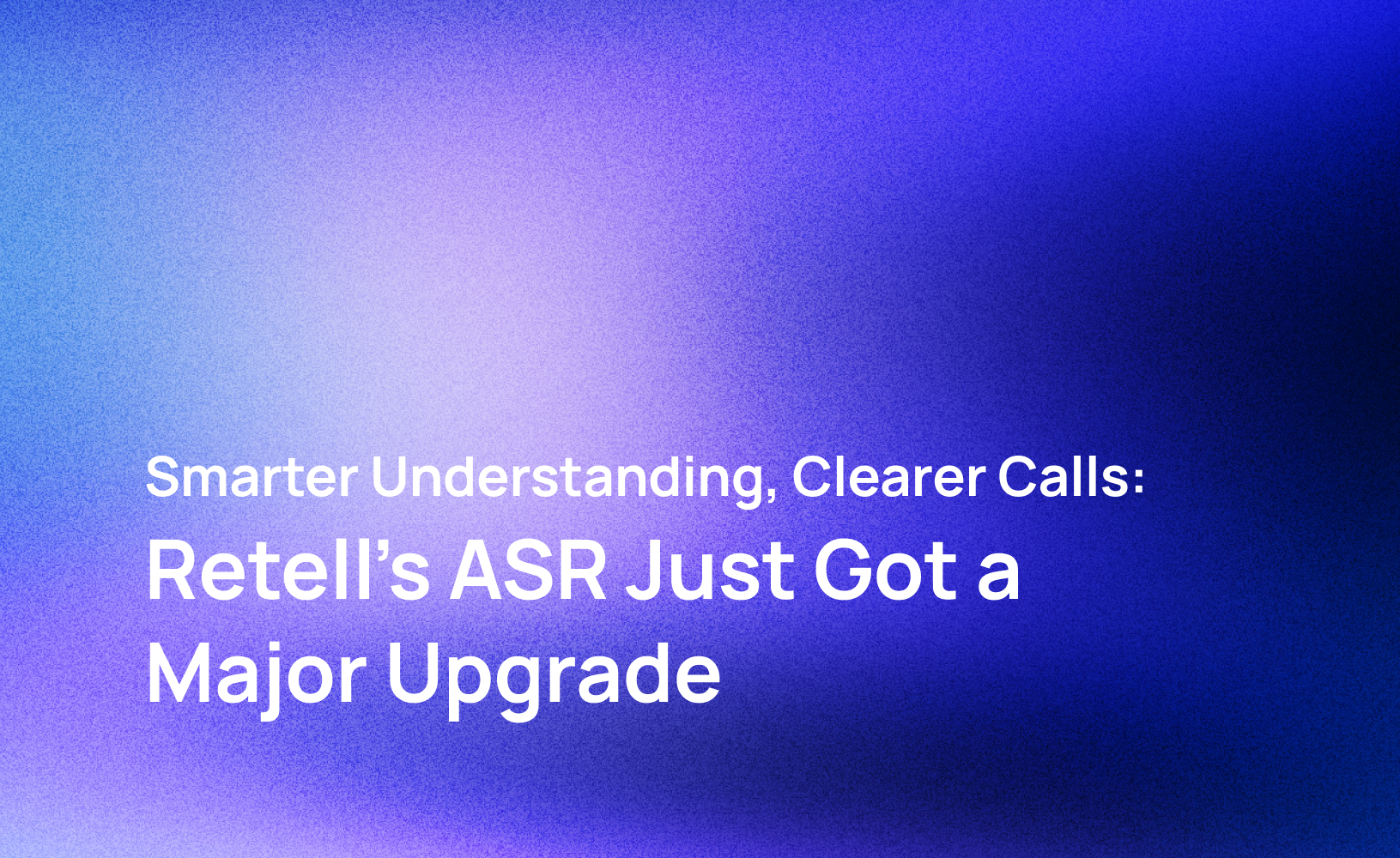Introduction — TL;DR
- Enterprise telephony is being rewritten by AI. Voice bots now deliver near-human conversations, real-time analytics, and unlimited scale—transforming contact centers from cost centers into growth engines.
- Global market momentum underlines the shift. Analysts value the AI voice market at USD 5.2 billion in 2023 and project USD 26.8 billion by 2032 (20.1 % CAGR) (DataIntelo).
- North America still leads, but Asia-Pacific is the sprinting challenger. APAC is forecast to post the highest regional growth thanks to exploding smartphone penetration and digital programs (DataIntelo).
- More enterprises jump in every quarter. Deloitte research shows 34 % of businesses adopted voice recognition in 2023 (SEO Sandwitch), and over 60 % plan to boost voice-AI budgets by 2026 (ProfileTree).
- Retell AI mirrors these shifts. The YC-backed platform lets brands design, deploy, and monitor multilingual voice agents that slot into Twilio, SIP trunks, or verified numbers—streamlining everything from inbound triage to outbound campaigns (Retell AI Blog).
1. Hyper-Natural Speech & Emotional Resonance
- Synthetic voices no longer sound synthetic. Providers now blend advanced neural TTS with linguistic “style tokens,” delivering tone, pacing, and micro-pauses that mirror human idiosyncrasies—“natural-sounding AI voices are becoming the norm, reducing customer frustration and increasing satisfaction” (ProfileTree).
- Emotional tagging upgrades empathy. Modern models detect sentiment in real time and switch vocal timbre (e.g., softer apology mode for angry callers) to maintain rapport.
- Brand identity becomes audible. Enterprises increasingly commission custom voice personas—think friendly fintech vs. authoritative healthcare. Retell AI offers pre-trained voices optimized for conversational depth that can jump-start such branded personas (Retell AI Blog).
2. Context-Retaining Conversational AI
- Remembering earlier statements is table stakes. Callers expect follow-up questions without re-explaining themselves; Retell AI’s live context retention “ensures agents remember previous interactions within a call” (Retell AI Blog).
- Dynamic dialogue management trumps rigid IVR trees. Large Language Models (LLMs) generate responses on the fly, branch logically, and loop back for clarifications—eliminating “Press 1 for…” frustrations.
- Outcome-driven scripting, not keyword roulette. Designers set guardrails (PCI redactions, compliance boundaries) while the agent negotiates, schedules, and troubleshoots in real time. Businesses moving “from basic voice automation to advanced conversational AI that can handle complex queries” gain higher first-call resolution (ProfileTree).
2.1 Warm Transfers & Hybrid Handoffs
- Seamless escalation protects CSAT. Retell AI “allows for warm transfers with hand-off messages, ensuring the next agent is prepared” (Dasha.ai).
- Agents join informed. Summaries, intent scores, and caller sentiment surface inside the CRM the instant a human rep answers, accelerating empathy and resolution.
3. Multilingual & Global Reach
- Voice-AI growth is global, not a one-language story. Asia-Pacific’s outsized CAGR (18.5 %) underscores demand for Mandarin, Hindi, Bahasa, and beyond (SEO Sandwitch).
- Real-time language switching declutters queues. Agents identify language preference from caller metadata or speech, then swap TTS/STT pipelines without legwork.
- Regulatory localization matters. Whether it’s GDPR in Europe or PDPA in Singapore, platforms like Retell AI conform to global standards, easing multinational rollouts (EliteAI.tools).
4. No-Code Builders & Extreme Customization
- Democratizing bot creation cuts IT bottlenecks. Drag-and-drop flow builders let ops teams add a new follow-up question before lunch—“no-code bot builder with NLP capabilities” is now a purchase requirement (AI in Business News).
- Vertical-specific templates speed ROI. Healthcare appointment reminders differ from fintech loan deferrals; modern builders surface proven blocks that still allow custom logic.
- Tailored solutions beat cookie-cutter bots. “The ability to provide tailored solutions addressing the specific needs of different enterprise sizes is a key market differentiator” (DataIntelo). Knowledge-base auto-sync features in leading platforms ensure each agent speaks with vertical authority.
5. Deep Analytics & Compliance by Design
- Metrics move from “calls handled” to “intent success.” Over 70 % of enterprises cite advanced analytics as a critical buying factor (AI in Business News). Retell’s sentiment dashboards highlight friction points and uncover training or product issues.
- Security certifications reassure risk officers. Retell AI adheres to SOC 2, HIPAA, and GDPR regulations, enabling deployment in healthcare and finance (EliteAI.tools).
- Automatic redaction for sensitive data. Enterprise-grade voice platforms provide PCI-compliant masking of credit-card numbers, Social Security digits, and PHI, safeguarding customers and auditors alike.
5.1 Post-Call Intelligence
- AI-generated summaries accelerate follow-ups. Reps get bullet-point action items inside Salesforce seconds after hang-up.
- Searchable audio archive fuels QA. Supervisors can query “refund escalation” and jump to flagged snippets, shortening coaching cycles.
6. Elastic Scaling & Outbound Automation
- AI removes head-count ceilings. Voice agents “can handle millions of concurrent interactions” thanks to cloud auto-scaling (Retell platform capability).
- Batch dialing meets compliance. Retell’s campaign tool “enables hundreds of outbound calls without hitting concurrency limits” (Dasha.ai). TCPA, Ofcom, and local quiet-hour rules are baked in.
- Event-driven triggers drive micro-journeys. Shipping delay? Proactive outage notice? Agents call affected customers, update CRM status codes, and even collect make-good offers.
7. Ecosystem Integration & API-First Architecture
- Open APIs preserve existing telephony. Retell supports SIP, Twilio, and Vonage out of the box, meaning no forklift upgrades.
- CRM & workflow symbiosis. “Integration with existing CRM and analytics platforms is a major trend” (ProfileTree). Apps like Cal.com and n8n orchestrate cross-channel journeys: missed call → SMS recap → email survey.
- Developer velocity stays high. For advanced teams, single-call speech-to-speech endpoints (like OpenAI real-time API) simplify prototypes, yet Retell’s low-code layer keeps Business Ops in the driver’s seat.
8. ROI & Operational Impact
- Speed meets savings. Deploying AI voice agents “can reduce average call handling time by up to 30 %” (Callin.io), freeing teams for high-empathy interactions.
- Revenue capture rises. Smarter routing slashes abandon rates; outbound bots revive dormant leads at negligible marginal cost.
- Scalability minus burnout. AI absorbs seasonal surges (e.g., holiday retail) without overtime or morale hits, then idles cost-effectively.
9. Competitive Landscape Snapshot
- Big tech meets specialized upstarts. The arena features Google, Amazon, Apple—plus niche innovators challenging the status quo (DataIntelo).
- Differentiation hinges on flexibility. Startups “offer more customizable and affordable AI voice solutions” while enterprises prize vendor stability (ProfileTree).
- Retell AI’s positioning. With live context retention, warm transfers, branded caller IDs, and compliance credentials, Retell “is the clear choice for businesses seeking a feature-rich AI phone agent platform” (Retell AI Blog).
10. Action Checklist for Call-Center Leaders
- Audit interaction journeys. Flag repetitive queries (balance checks, appointment reminders) ripe for automation.
- Prioritize integrations. Ensure any AI voice vendor plugs into your CRM, ticketing, payment gateways, and identity providers.
- Prototype fast, measure faster. Launch a small queue with clear KPIs—handle time, CSAT, containment rate—then iterate weekly.
- Train for collaboration. Equip human agents to read AI summaries, accept warm transfers, and escalate only when necessary.
- Plan for compliance. Select platforms with baked-in HIPAA, PCI, and SOC 2—and validate redaction in staging.
- Budget for voice persona. Invest in custom TTS that embodies your brand rather than settling for generic.
11. Responsible AI & Future-Proofing
- Regulations are tightening worldwide. Emerging frameworks such as the EU AI Act and U.S. state-level privacy bills will shape deployment standards. Choosing vendors with transparent data-handling practices—and voluntary third-party audits—reduces future re-engineering costs.
- Ethical design earns customer trust. Features like explicit disclosure (“This call is handled by an AI agent”) and accessible opt-outs help maintain transparency, while bias monitoring ensures equitable service across accents, ages, and dialects.
- Continuous iteration is non-negotiable. As LLMs evolve, model updates can unlock higher containment and richer personalization; a modular platform lets enterprises roll these advances into production without downtime.
Conclusion: Voice AI’s Future Sounds Bright
- Market forces are undeniable. Spending is climbing double digits, and enterprises worldwide are racing to deploy conversational solutions.
- Technology gaps are closing. Neural TTS, real-time emotion detection, and context retention make today’s bots indistinguishable from human agents during routine tasks.
- Competitive advantage favors early movers. Brands that standardize on adaptable, compliant platforms—like Retell AI—will enjoy happier customers, lower costs, and data-rich insights.
- The takeaway: Follow these trends, prototype strategically, and your call center will evolve from reactive cost sink to proactive growth catalyst.
FAQ Section
What is the projected market growth for AI voice technology?
The AI voice market is valued at USD 5.2 billion in 2023 and is projected to grow to USD 26.8 billion by 2032, with a CAGR of 20.1%.
How does AI improve call center efficiency?
AI voice agents can handle millions of interactions concurrently, reducing average call handling time by up to 30% and increasing customer satisfaction through real-time, human-like interactions.
What are the regional trends in AI voice technology adoption?
North America leads in AI voice technology adoption, but the Asia-Pacific region is expected to see the highest growth due to increasing smartphone penetration and digital initiatives.
How does Retell AI enhance customer interactions?
Retell AI provides multilingual support, real-time emotion detection, and context-retaining capabilities, allowing seamless communication and improved customer experiences.
What compliance features are supported by AI voice platforms?
AI voice platforms like Retell AI adhere to standards like SOC 2, HIPAA, and GDPR, offering compliance with security certifications and automatic redaction of sensitive information.
How do AI voice agents handle emotional or frustrated callers?
Modern platforms detect sentiment in real time and adjust tone or escalate to a human rep, Retell AI automatically routes negative sentiment calls with context and transcript to preserve customer experience.
Can AI agents switch languages mid-call?
Yes. Platforms like Retell AI can detect a change in caller language or preference and dynamically adjust TTS and ASR pipelines during the same interaction.
Do I need to change my phone provider to use AI voice agents?
No. Retell AI supports SIP, Twilio, and Vonage out of the box, so enterprises can keep their current carriers and numbers.
How long does it take to launch a voice AI agent?
Most companies can deploy a production-ready agent within a week using Retell AI’s no-code builder, CRM integrations, and verified number support.
What metrics should I track to measure AI call agent performance?
Track average handle time, first-call resolution, CSAT, abandonment rate, and revenue influenced. Retell AI provides built-in dashboards for all of these KPIs.
Citations



